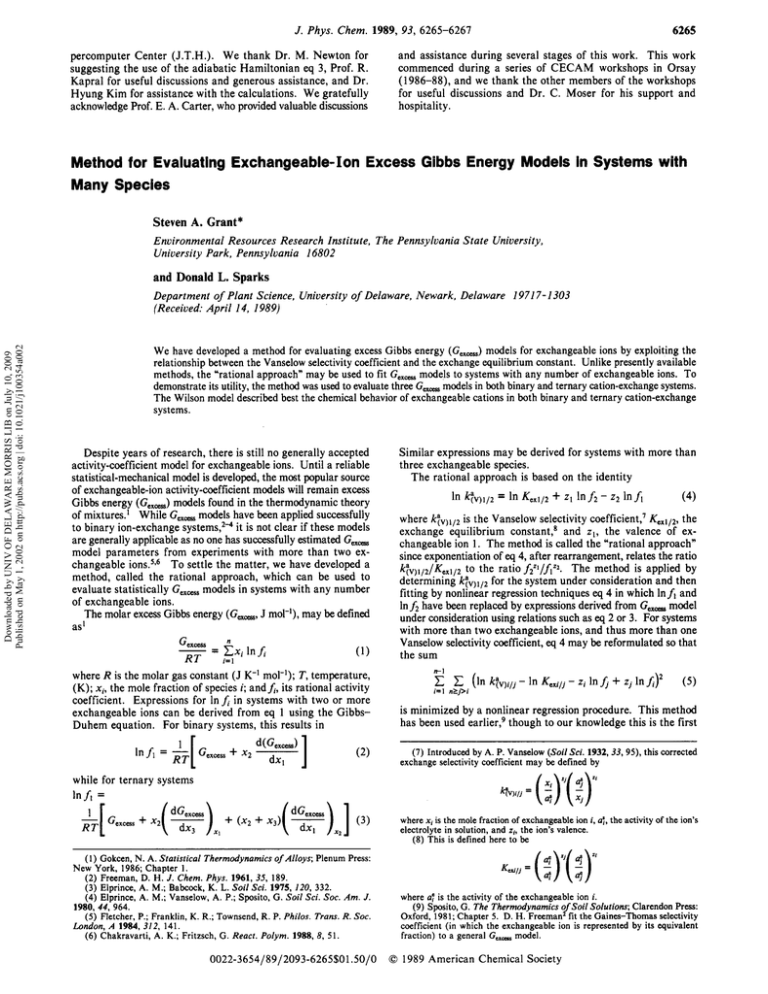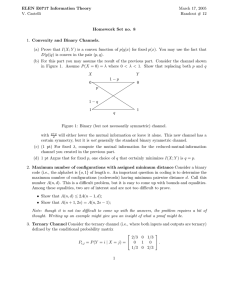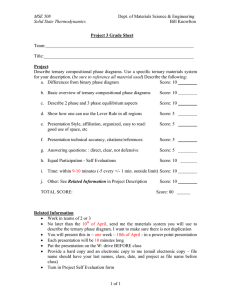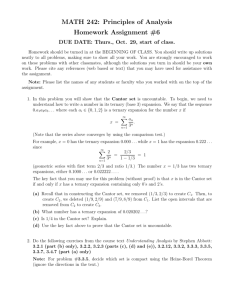Document 10766184
advertisement

J. Phys. Chem. 1989, 93, 6265-6267 percomputer Center (J.T.H.). We thank Dr. M. Newton for suggesting the use of the adiabatic Hamiltonian eq 3, Prof. R. Kapral for useful discussions and generous assistance, and Dr. Hyung Kim for assistance with the calculations. We gratefully acknowledge Prof. E. A. Carter, who provided valuable discussions 6265 and assistance during several stages of this work. This work commenced during a series of CECAM workshops in Orsay (1986-88), and we thank the other members of the workshops for useful discussions and Dr. C. Moser for his support and hospitality. Method for Evaluating Exchangeable-Ion Excess Gibbs Energy Models in Systems with Many Species Steven A. Grant* Environmental Resources Research Institute, The Pennsylvania State University, University Park, Pennsylvania 16802 and Donald L. Sparks Downloaded by UNIV OF DELAWARE MORRIS LIB on July 10, 2009 Published on May 1, 2002 on http://pubs.acs.org | doi: 10.1021/j100354a002 Department of Plant Science, University of Delaware, Newark, Delaware 1971 7-1303 (Received: April 14, 1989) We have developed a method for evaluating excess Gibbs energy (Gea-) models for exchangeable ions by exploiting the relationship between the Vanselow selectivity coefficient and the exchange equilibrium constant. Unlike presently available methods, the “rational approach” may be used to fit G,, models to systems with any number of exchangeable ions. To demonstrate its utility, the method was used to evaluate three G,,, models in both binary and ternary cation-exchange systems. The Wilson model described best the chemical behavior of exchangeable cations in both binary and ternary cation-exchange systems. Despite years of research, there is still no generally accepted activity-coefficient model for exchangeable ions. Until a reliable statistical-mechanical model is developed, the most popular source of exchangeable-ion activity-coefficient models will remain excess Gibbs energy (Gex,) models found in the thermodynamic theory models have been applied successfully of mixtures.’ While G,, to binary ion-exchange systems,24 it is not clear if these models are generally applicable as no one has successfully estimated G,, model parameters from experiments with more than two exchangeable ions.’v6 T o settle the matter, we have developed a method, called the rational approach, which can be used to evaluate statistically G,,, models in systems with any number of exchangeable ions. The molar excess Gibbs energy (G,,, J mol-’), may be defined as‘ where R is the molar gas constant (J K-’ mol-’); T, temperature, (K); xi, the mole fraction of species i; andf,, its rational activity coefficient. Expressions for In f, in systems with two or more exchangeable ions can be derived from eq 1 using the GibbsDuhem equation. For binary systems, this results in Similar expressions may be derived for systems with more than three exchangeable species. The rational approach is based on the identity In kaV)’/2 = In Kexl/2 + z1 l n f 2 - z2 l n f ’ (4) where kiV)1/2is the Vanselow selectivity ~oefficient,~ Kcxl/2,the exchange equilibrium constant,8 and zI, the valence of exchangeable ion 1. The method is called the “rational approach” since exponentiation of eq 4, after rearrangement, relates the ratio k?v)1/2/.Kex1/2 to the ratio f2’l/fIi’2. The method is applied by determining kiv)l,2 for the system under consideration and then fitting by nonlinear regression techniques eq 4 in which lnfl and In& have been replaced by expressions derived from G,,, model under consideration using relations such as eq 2 or 3. For systems with more than two exchangeable ions, and thus more than one Vanselow selectivity coefficient, eq 4 may be reformulated so that the sum n-l E E i=l n 2 p i (In ktv)i,j - In KeXilj- zi In fi + zj In (5) is minimized by a nonlinear regression procedure. This method has been used earlier: though to our knowledge this is the first (7) Introduced by A. P. Vanselow (Soil Sei. 1932, 33, 9 9 , this corrected exchange selectivity coefficient may be defined by while for ternary systems In f l = kiV)i,j = (:)( ;) where xi is the mole fraction of exchangeable ion i, a:, the activity of the ion’s electrolyte in solution, and zi, the ion’s valence. (8) This is defined here to be (1) Gokcen, N. A. Statisrical Thermodynamics of Alloys; Plenum Press: New York, 1986; Chapter 1. (2) Freeman, D. H. J. Chem. Phys. 1961,35, 189. ( 3 ) Elprince, A. M.; Babcock, K. L. Soil Sci. 1975, 120, 332. (4) Elprince, A. M.; Vanselow, A. P.; Sposito, G. Soil Sci. SOC.Am. J . 1980, 44, 964. ( 5 ) Fletcher, P.; Franklin, K.R.; Townsend, R. P. Philos. Trans. R. SOC. London, A 1984, 312, 141. (6) Chakravarti, A. K.; Fritzsch, G. React. Polym. 1988, 8, 51. where a: is the activity of the exchangeable ion i. (9) Sposito, G. The Thermodynamics o Soil Solutions; Clarendon Prcss: Oxford, 1981; Chapter 5 . D. H. Freeman fit the Gaines-Thomas selectivity coefficient (in which the exchangeable ion is represented by its equivalent fraction) to a general,,G model. 0022-3654/89/2093-6265$01 .50/0 0 1989 American Chemical Society 4 6266 The Journal of Physical Chemistry, Vol. 93, No. 17, 1989 Letters TABLE I: Expression for Exchangeable-Ion Activity Coefficients in Binary and Ternary Systems Derived from Three Excess Gibbs Energy Models activity coefficient models excess Gibbs energy model for binary systems for ternary systems Wilson model + lnfi = -xl In ( 1 - a3/lx3 - a211x2)+ x2(ln (1 - a312x3- u l / 2 x I )+ In fi = -x2 In ( 1 - a 2 / I x 2 ) (a3/2 - a1/2)x2 - a3/2x3 - a1/2xl + a3/lxl - a3/lx3 - a 2 / 1 x 2 al/3x3 - a 2 / 3 x 2 - a1/3x1 Downloaded by UNIV OF DELAWARE MORRIS LIB on July 10, 2009 Published on May 1, 2002 on http://pubs.acs.org | doi: 10.1021/j100354a002 TABLE 11: Ternary Excess Gibbs Energy Model Coefficient Values Estimated by Nonlinear Regression from Binary and Ternary Cation-Exchange Data cation-exchange data used ternary excess Gibbs energy model regular solution coefficient 0'2 a13 subregular solution A I (=A12 A2 (=A21 Wilson A3 (=A31 A1/2 Al/3 '4211 A2/3 A3/l A3/2 + A131 + A23) + A32) binary estimate asymptotic std error estimate asymptotic std error 0.0885 -0.0986 -0.4584 0.0597 2.1859 -2.9212 -0.0809 0.6695 0.4609 -0.5807 -1.4857 0.5751 0.2168 0.1734 0.0930 1.4001 2.0886 1.5239 1.2693 1.0017 0.8899 2.231 1 2.6209 1.2624 0.4232 1.3766 -1.3200 -1.5077 2.6614 -0.1254 -0.8768 -0.5413 0.9271 0.7847 -1.2842 0.4171 0.2948 0.4653 0.3746 0.9718 0.9582 0.8 159 1.1766 0.7543 0.41 76 0.4319 1.6311 0.4996 time it has been used systematically to evaluate several,,G models or used to estimate G,, model parameters from ternary ion-exchange data. In the implementation of the rational approach, In K e ~ lmay i be treated as another coefficient to be fit during regression evaluation of eq 4 or it may be calculated separately and its calculated value treated as a constant during the regression evaluation. In most situations, its estimated value will be affected, model from which lnfr and sometimes dramatically, by the,,G G models are to be In f2 in eq 4 are derived. If several , evaluated using the rational approach, it may be better to estimate In Kexiljby the Argersinger approachlo before evaluating these models. Similarly, if three complimentary binary ion-exchange systems (e.g., NH4-Ba, Ba-La, and La-NH4) are to be studied, the values of the three In Kexiljvalues are related by the triangle rule." This constraint is not easily inserted into the regression evaluation of each set of binary ion-exchange data. To demonstrate the utility of the rational approach, three C,,, models (regular-solution, subregular-solution and Wilson) were evaluated in a ternary and three binary cation-exchange syst e m ~ . ' ~ -Representations '~ of eq 2 and 3 for each of these models in both binary and ternary systems are presented in Table I.I5 Two aspects of the candidate models were evaluated: (1) their ability to describe accurately In kiv)ilj in binary and ternary systems and (2) whether model-coefficient estimates calculated from binary data accurately predicted In kiv)ilj in ternary experiments. The data of Elprince et al., who studied NH4-Ba-La exchange on a montmorillonite clay, were a n a l y ~ e d .The ~ Vanselow selectivity coefficient was calculated by (IO) Argersinger, W. J.; Davidson, A. W.; Bonner, 0. D. Trans. Kansas Acad. Sci. 1950, 53, 404. The exchange equilibrium constant may be calculated by evaluating the integral (13) Hardy, H. K. Acta Metoll. 1953, I , 202. (14) Wilson, G. M. J. Am. Chem. SOC.1964, 86, 127. ( I 5) The following served the sources for the G,, models evaluated: binary and ternary regular solution, Gokcen,' eq 4.7 (for S a , , = 0);binary subregular solution, Hardy," eq 1; ternary subregular solution, J. Grover, (In Thermodynamics in Geology; Fraser, D. G.,Ed.; D. Reidel: Dordrecht, The Netherlands, 1977). eq 37; binary and ternary Wilson, Wilson," eq I . (16) Harned, H. S.; Owen, B. B. The Physical Chemistry of Electrolyte Solutions; Reinhold: New York, 1958; Appendix. (17) In K,,,/,, 2.21602778; In KCxh/NHI,-0.9176944; In K e r ~ a / ~ ~ 4 , -1.3504722. (18) Symbolics, Inc. VAX UNIX MACSYMA Reference Manual Version 1 1 ; Symbolics, Inc.: Cambridge, MA, 1985; Chapter 2. where El is the equivalent fraction of exchangeable ion i. ( I I ) The so-called triangle rule (see Helfferich, F. G. Ion Exchange; McGraw-Hill: New York, 1962; Chapter 5 ) relates three complementary exchange equilibrium constants algebraically by zk In + zi In K,,/k + Z, In K,,k I = 0. (12) Aildebrand, J. H. J . Am. Chem. SOC.1929, 51, 66. where mt is aqueous molality (mol kg-3) of the chloride salt of cation "i" and y f iClz,, the mean ionic activity coefficient for this salt in solution. The mean ionic activity coefficients for each salt a t a given ionic strength were calculated f r o m t h e data tabulated by Harned and Owen.16 The exchange-equilibrium constants were calculated before the models were teste4I.l' Equations 2-5 for each G , model were evaluated using MACSYMA.I8 Letters The Journal of Physical Chemistry, Vol. 93, No. 17, 1989 6267 TABLE 111: Total Sums of Sguares and Residual Sums of Sguares by Nonlinear Regression to Three Excess Gibbs after Fitting In qv),,, Energy Models exchange system modeled La-Ba La-N H4 Ba-NH4 Downloaded by UNIV OF DELAWARE MORRIS LIB on July 10, 2009 Published on May 1, 2002 on http://pubs.acs.org | doi: 10.1021/j100354a002 La-Ba-NH4 TSS 11.827 8.751 9.319 3.895 excess Gibbs energy model regular solution subregular solution Wilson regular solution subregular solution Wilson regular solution subregular solution Wilson regular ternary data regular binary data subregular ternary data subregular binary data Wilson ternary data Wilson binary data RSS 12.919 10.503 11.415 4.604 4.541 4.532 5.840 5.690 5.569 3.086 34.845 4.825 6.955 1.597 98.692 Statistical evaluations of the G , models were performed using the Gauss-Newton method of the N L I N procedure in the SAS statistical package.lg In some cases it may be assumed that exchangeable cations behave as if in an ideal mixture; that is,f; and, consequently, k?v)i/j are independent of exchangeable-cation composition. This would be the case if the experimentally estimated coefficients for the model, the regular solution, were zero. Inspection simplest,,G of the binary regular-solution model-coefficient estimates and their asymptotic standard errors presented in Table I1 indicated that coefficients in two of the binary cation-exchange systems were not zero. Accordingly, it is appropriate with these data to develop or select an exchangeable-cation activity-coefficient model. Table 111 presents the total sum of squares (TSS), corrected for the mean, for the In kiv)ilj values in both the binary and ternary experiments along with the residual sums of squares (RSS) associated with the nonlinear regression of each model.20 Two RSS values are presented for each model when applied to ternary systems; one was calculated using the G,,,,, model coefficients estimated from ternary data and the other using coefficients estimated from binary data. These RSS values indicate that all three of the G , models evaluated could be used to describe the binary cation-exchange data. Use of either the regular-solution or Wilson models with ternary cation-exchange data reduced the RSS below the TSS. With the regular-solution model, the reduction in the RSS was modest, indicating that the Wilson model might be conditionally preferred. Still, it should be noted that the differences in the predictions by the regular-solution and Wilson models in ternary cation-exchange systems were small, (19) SAS Institute Inc. SAS User's Guide: Stafisrics, Version 5 Edition; SAS Institute Inc.: Cary, NC, 1985; Chapter 25. ( 2 0 ) In Table 2, the total sum of squares, corrected for the mean, is defined to be a. * ' 1 I 0 o -' -2 1 I Wilson-ternary Reg. tol.-tem I 2 1 3 Measured In k(v)i/j b. 2 0 y u 0% ' 1 Wilson-ternary Wilson-binary 0 -2 I I I L J Measured In h(v)i/j Figure 1. (a) Plot of residuals of In k:v,,,,, values measured in ternary cation-exchange experiments and those predicted by using Wilson and regular-solution model coefficients estimated using the ternary cationexchange data. (b) Plot of residuals of In k:v),, values measured in ternary cation-exchange experiments and those prdicted by using Wilson model coefficients estimated using either binary or ternary cation-exchange data. as can be seen in Figure l a , which shows a plot of the residuals for the In k&),, values predicted by these two models. Wilson model coefficients determined from binary cation-exchange experiments could not be applied successfully to ternary systems. The ternary system RSS for the Wilson model coefficients determined in binary systems were many times higher than the RSS resulting from using coefficients determined in the ternary system. This disparity is presented graphically in Figure lb. Excess Gibbs energy models have been widely used to describe the thermodynamic properties of solid and liquid mixtures,'S2' but until now the appropriateness of these models for exchangeable ions could not be tested conclusively since no technique existed to apply these models to multispecies ion-exchange systems. Using the rational approach, three candidate G,,, models in both binary and ternary ion-exchange systems could be evaluated directly and the appropriate model coefficients estimated. We believe that this tool will facilitate the development and evaluation of exchangeable-ion GeXCeSS models for systems with numerous exchangeable species. and the residual sum of squares Acknowledgment. This work was supported by Grant 971-85 from the US-Israel Binational Agricultural Research and Development Fund (BARD). We express appreciation for the insightful comments and criticisms of R. H. Wood, Z . Z. Zhang, and D. H. Freeman. where In k&,,,,,is the mean value of In klV)1/2 in the data set under consideration and J ( i ) is the value of In kiv)l12predicted using the C ,, model under consideration. (21) Abrams, D. S.; Prausnitz, J. M. AIChE J . 1975, 21, 116. See also Wilson14 and Grover.15







